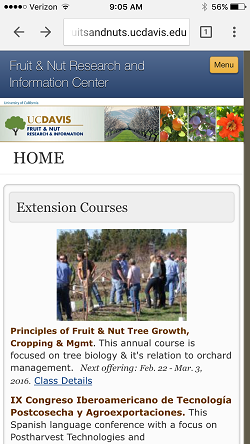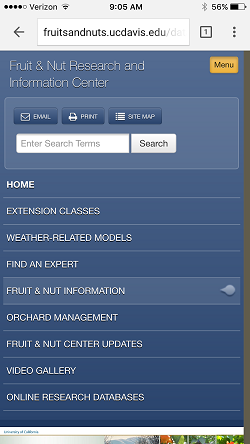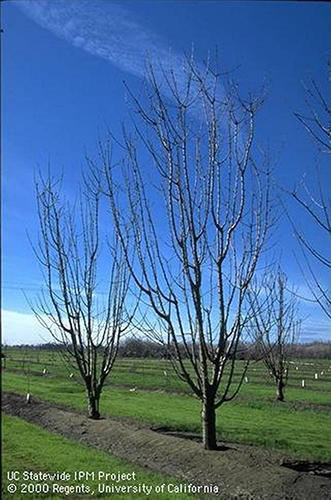
- Author: Julie Jacquemin
Brokaw Nursery, located in Ventura County, is seeking a motivated employee to spearhead their in-house nursery trials and experimental efforts. Brokaw Nursery is one of California's largest suppliers of wholesale subtropical orchard trees, serving not only the California market but also many countries worldwide. Brokaw nursery currently employs approximately 50 full time employees.
They seek a full time candidate who has the ability to excel in a fast paced and detailed environment. This position reports directly to the company's International Relations and R&D Director and supports the Operations team. Brokaw Nursery, LLC offers a competitive compensation and benefit package as well as professional growth opportunities.
REQUIREMENTS
- Proficiency in applied horticulture in both field and laboratory settings.
- Understanding of the scientific method related to horticulture including literature review, experimental design, and appropriate statistical evaluation.
- Strong organizational, analytical and people skills sufficient to provide timely and constructive feedback on issues related to the nursery and horticultural industries.
- Ability to structure and complete tasks independently.
- Proficiency in Microsoft Office Suite.
- A bachelor's degree or higher is required; preferably in horticulture or plant science, with consideration given to degrees in other corresponding disciplines including water/soil science, entomology, or plant pathology.
- Education, training, or experience in horticulture and/or nursery practices is preferred, and relevant experience in other permanent cropping systems will be considered.
- Excellent written and oral communication skills.
- Proficiency in Spanish desired
DUTIES & RESPONSIBILITIES
- Develop, conduct and analyze domestic nursery, orchard, and laboratory trials.
- Prepare reports and summaries of these trials that include interpretation of results and recommendations for implementation.
- Represent Brokaw Nursery at technical events including industry meetings, seminars and other educational functions.
- Assist and advise Nursery Manager as needed.
- Additional special projects as needed.
- Possible international travel to participate in research activities in other growing regions.
Hours: 8:00 a.m. to 4:30p.m. Monday‐Friday,1/2 hour lunch
Reply with Resume and Cover letter to mike@thebelmontgroup.com
Contact
Michael G. Skaff, CPA
Cell: (559) 679-4996 Â Office: (559) 625-9800
3500 W Orchard CT
Visalia, CA Â 93277
www.thebelmontgroup.com
Horticulturist Posting
- Author: Rika Fields
- Editor: David Alexander Foster
 Tom Gradziel
Tom Gradziel
Breeding trees takes a long time, says Tom Gradziel, a geneticist at the University of California, Davis. He knows this because he's spent the last twenty years breeding almonds and peaches for California's booming fruit and nut industry. He's breeding a variety of peaches better-suited for mechanical harvest and a variety of self-pollinating almonds. He predicted the need for these varieties years ago because as a breeder, that's how Tom has to think. “The breeder has to be in tune with the industry in terms of what problems need solving and how to pragmatically go about finding those solutions,” he declares. He thinks ahead twenty years and selects traits to breed now based on what he thinks the industry needs in the future.
These days he's anticipating a need for trees that are less susceptible to January heat. He says that heat spells during the beginning stages of fruit development are already causing marginal issues such as bud failure or abnormal fruit development. His fear is that this will become more common, to the point where farmers will experience crop loss. The solution he finds most promising? Selecting for cultivars that are tolerant to a wider range of climatic conditions, ones that will not be derailed as easily by unexpected heat spells.
Tom tests cultivars on several plots under a variety of conditions before he releases them to growers. Long-term testing is an important aspect of what Tom does and is the reason why breeding takes such a long time. The process is long but it mitigates risks to growers by ensuring the trees grow well in whatever environment they're planted. There's always room for improvement, however, and Tom's greatest career accomplishment is his optimization of this process.
Building upon research conducted by Ted DeJong, a professor and pomologist at UC Davis, Tom improved the efficiency of his tree breeding program by mechanizing the pruning and flower-thinning of his trees. It allowed him to see uniform fruit on branches and allowed him to keep entire seedling blocks rather than eliminate imperfect trees. “You end up with something close to the true genetic potential,” Tom proclaims, “you're seeing what the maximum genetics can produce.” For his breeding program, Tom gets help from many outside sources, including the UC Cooperative Extension.
The cooperative extension system has been crucial to Tom's breeding endeavors because it has given him a large network to collaborate with. From the USDA to farm advisors, extensions specialists, nurseries, and growers themselves, Tom works with all these groups to test his trees. “We have a web of information going from the university to the growers and just as importantly from the growers and processors back to the university,” Tom states. Not only does this network help him in his experiments, they give him a reality check: nurseries and growers will tell him which solutions might work and what won't pass in the industry.
Tom wants to share with all growers this insight: tree selection is like a marriage. He calls it the Anna Karenina Principle, alluding to the first line of Leo Tolstoy's famous novel: “All happy families are alike; each unhappy family is unhappy in its own way.” Tom's point is that growers shouldn't choose a tree because it has one trait they really like. The tree they choose may be great for a few years but may be taken out by an especially strong gust of wind or a pathogen it's not resistant to. Instead, Tom says, growers should choose a tree that hasn't shown any flaws and will still be producing twenty years down the line.
- Author: Krista Rindell
Happy 2016 from the Fruit and Nut Research and Information Center!
We want to take a moment to remind you that the FNRIC website is fully formatted to be compatible with mobile browsing from cell phones and tablets. This includes all of our pages and links, such as the chill calculators, fruit and nut information and the research databases. By being mobile compatible you can access all of our information from anywhere you are be it traveling, in the field or simply away from a computer.
To access our website from your phone or tablet all you need to do is open your favorite browser and type in fruitsandnuts.ucdavis.edu. Once our homepage is loaded you can browse our information and follow the links just as you would from your computer. Below are some screenshots of what you will see when accessing our website from a mobile device.
If you encounter any issues or have questions please email us at fruitsandnuts@ucdavis.edu.


- Author: Janet M. Zalom

The simplest models developed to estimate chill accumulation use a simple count of the number of hours in which the temperature is below 45°F (Chill Hours). However, there is a concern with the chill hour models, particularly under mild winter conditions, such as last year. From the perspective of tree physiology, when cold winter nights (below 45°F) are immediately followed by warm winter days (above 75°F), some of the accumulated chill can be cancelled out, and the Chill Hour model does not account for this. The Dynamic Model was developed to respond to these conditions. It counts chill accumulation (Chill Portions) during hours below a temperature threshold, but then eliminates that accumulation if cold temperatures are followed by warm temperatures within a 24 hour time span.
Regardless of which model you are watching, the current season is chilly, so far. Both Chill Portions and Chill Hours are higher than 5-year averages (tables below). Does this mean we will meet the chilling requirement for your trees? It is too early to say for sure but we are off to a great start!
For excellent references for the chilling requirements of various crops, including variety-specific details, see: Fruit & Nut Crop Chill Portion Requirements by UCCE Orchard Advisor Katherine Pope and the table at the bottom of the webpage: Prune Chilling Prediction Model by UCCE Orchard Advisor Franz Niederholzer.
- Author: Cheryl Reynolds, UC IPM Program

Calculators from the Department of Pesticide Regulation (DPR) that determine the VOC emissions from fumigant and non-fumigant pesticides before application are available to help growers, pest control advisers, and pesticide applicators comply with the regulations. The UC Statewide Integrated Pest Management (IPM) Program provides a link to these calculators from each of the treatment tables in the UC Pest Management Guidelines and click on the Air Quality – Calculate emissions button.
Take steps to reduce VOCs. Avoid emulsifiable concentrate (EC) formulations as they release the highest VOC emissions. Pesticide control advisers and growers can also reduce VOC emissions by employing IPM practices such as using resistant varieties, traps, exclusion, and biological control. When using pesticides, spot-treat and seek low-emission materials. Solid formulations, such as granules or powders, are best.
Check the fact sheet on the DPR web site for the most up-to-date-information on VOC restrictions and regulations.


